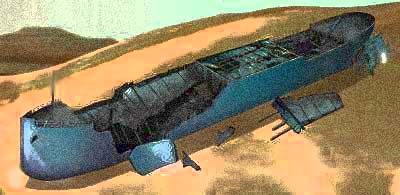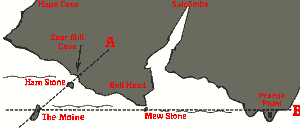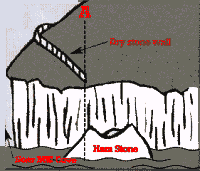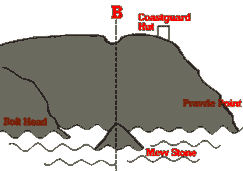 |
 |
History of the Maine
The Maine was built for the Sierra Shipping Company of Liverpool;
and was launched in 1905 under the name Sierra Blanca. She is 375
feet by 46 feet. Renamed in 1913 by the Atlantic Transport Company.
The 3616-ton British cargo ship, the Maine zig-zagged down the
Channel in the early hours of 23rd March, 1917. Through his periscope,
Oberleutnant Ralph Wenninger (of U-boat UC-17) spotted the Maine
and struck her full in the port side, level with her No.2 hold.
The explosion blew the hatches off No.2 and No.3 holds, smashed the port gig and wrecked her bridge with a gapping hole in her side flooding water onto her cargo of chalk, horsehair and goatskins. The Maines distress call was answered by the Royal Navy torpedo boat No.99 who recovered most of the crew. After struggling to tow the Maine towards land in order to beach her, her internal bulkheads collapsed and at 12:45pm she sank.
 |
Dive
Guide The Maine is one of the most popular dives in Devon as she is easily accessible and intact. Her propellers and the gun have been salvaged and the wreck now belongs to the Torbay Branch. The best place to aim the shotline is just over midships where the wreck of the Maine is fairly intact; this will put the divers in approx 30m. Swimming to the stern and back, with a quick look around the engine room, can be done comfortably in around 20-minutes leaving only a minimal decompression stop. It is best to be dropped onto the Maines bow; from here descend to the seabed and look along the bow for the walls of hydroids and plumose anemones, as well as the shoals of fish that seem to gather here. At the seabed you can choose to follow either side of the wreck. |
|
Port side: Along the port side, a break in the hull will become quickly visible, providing access to the remains of the forward holds where the UC-17s torpedo hit. Starboard side: On the starboard side of the wreck the hull is more intact. Follow the seabed from the bow and enter the hold through a large hole at the back of No 2 hold. |
Inside the wreck: If
you want to explore inside the wreck there is an easy route from here past
the boilers and into the engine room (which is now largely open from
above). There are some girders to manoeuvre past, but you are never more
than a few metres from an exit.
The next bulkhead is just a vertical skeleton separating engine room from
fuel tanks. A short diversion here is to swim through the remains of the
triple-expansion steam engine before carefully slipping through a gap in
the bulkhead into the fuel tanks. Powerful dive lights illuminate a pair
of colourful ladders in the middle of the tanks.
The aft holds are more intact and, as such, are sheltered from the
current. Exit is easily in reach through the large open cargo hatches, but
the remaining decking is tight girderwork, with gaps too small for a diver
to fit through.
The girders above are home to clumps of dead men's fingers and the
occasional sprig of red kelp. In the centre of the hold, the propshaft
tunnel is broken open but access is prevented by silt and debris.
At the stern it is possible to ascend through the decks and cabins in the
remains of the overhanging counter stern to examine the steering gear,
then look down to the seabed to view debris from the stern and the gun
platform.
By this point it is usually time to head back for the bows, unless you
want to build up some heavy decompression. A fast scoot along the port
railing past the remains of masts and rigging brings me back to the engine
room, where I can follow the collapsed plates back to the forward holds
and the bows.
Going forward past the breaks in the hull, it is possible to explore the
largely intact No 1 hold and ascend through the decks at the bows past
winches and a huge anchor.
General Info
| Tides: | On spring
tides it is essential to dive at slack water, two hours after high or
low water at Devonport. On a good neap tide an experienced diver can
haul down a shotline against the current and hide inside the wreck;
feasible from either an inflatable or a RIB. |
| Getting there: | Take the M5
and then the A38 towards Plymouth. Bear left onto the A381 to Totnes,
Kingsbridge and Salcombe. To get to Hope Cove, take a sharp right at
Malborough village just before reaching Salcombe. |
| Diving and air: | Mv Lodesman
has an onboard compressor and can provide a full package, including
accommodation onshore. If you are taking your own boat the Lodesman can
provide air fills at an arranged rendezvous, such as the slip in
Salcombe (01548 843319). Diventure at Salcombe runs a RIB shuttle and
offers air and nitrox fills (01548 843663),
Diventure. Some Plymouth
and Dartmouth boats may also venture as far as the Maine, e.g., Mount
Batten Dive Shop, Plymouth (01752 405403) |
| Launching: | A slip at
Hope Cove (Inner Hope) has a reasonable launch fee and is wet for just
an hour or two either side of high tide. When the slip is dry there is a
firm, sandy beach suitable for launching with a 4x4. At Salcombe the
slip in Shadycombe car park is usable throughout the tide. It is
expensive for a weekend but can be economical for a week or two, and is
best suited to large RIBs. |
| Accommodation:
|
There are many hotels, B&Bs and campsites in the area. Contact Tourist Information on 01548 843927. Further details on Salcombe On-line. |
| Qualifications: | Reasonably
experienced sport divers and above. It is NOT a dive for novices or
newly qualified divers. |
| Further information: | Admiralty
Chart 1613, Eddystone Rocks to Berry Head. Ordnance Survey map 202;
Torbay and South Dartmoor area. Dive South Devon by Kendall McDonald;
The Wreckers Guide to South Devon Vol 2, by Peter Mitchel. |
| Pros: | Spectacular
wreck that is reasonably intact and not too deep (28m to the sea bed). |
| Cons: | There may be
fishing nets/lines around the wreck. |
 How to find it:
How to find it:
GPS 50.12.820 N, 3.51.045 W
(degrees, minutes, decimals). The Maine is easy to find from transits:


Copyright © 2007 Chippenham Diving Club - BSAC1622 |